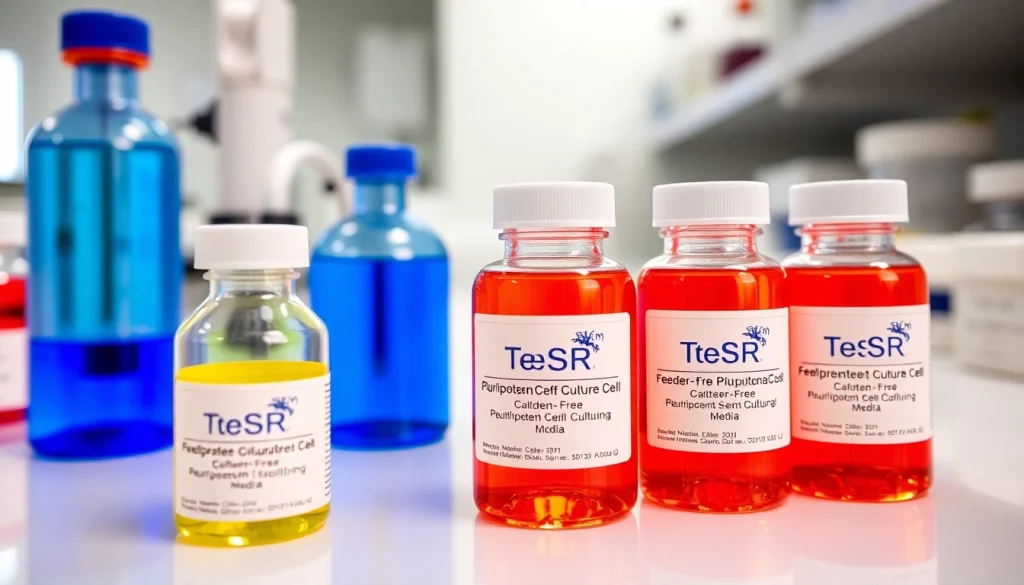The Importance of Feeder-Free Culture in Pluripotent Stem Cells
Pluripotent stem cells (PSCs) are unique in their ability to differentiate into nearly any cell type in the human body, making them invaluable in regenerative medicine and therapeutic applications. The culture conditions employed to maintain these cells are crucial for their health, longevity, and pluripotency. One of the most significant advancements in this area is the use of feeder-free culture systems, such as those provided by the TeSR™ media family, which offer various formulations tailored to the needs of researchers.
Understanding Pluripotent Stem Cells
PSCs include both embryonic stem cells (ESCs) and induced pluripotent stem cells (iPSCs). These cells are characterized by their ability to self-renew indefinitely and differentiate into any cell lineage. The study of pluripotent stem cells is essential to understanding development, disease mechanisms, and potential therapeutic strategies in regenerative medicine. Given their capabilities, maintaining their integrity and functionality under culture conditions is paramount.
Benefits of Feeder-Free Culture Systems
Feeder-free culture systems have revolutionized PSC maintenance by eliminating the need for feeder layers, typically derived from animal tissues. This advancement brings several benefits:
- Consistent Growth Conditions: Feeder-free systems provide uniform nutrient availability, minimizing batch-to-batch variability.
- Reduced Contamination Risk: By controlling the environment and using defined media, the risk of microbial contamination significantly decreases.
- Enhanced Reproducibility: Defined formulations enhance the reproducibility of experimental results, aiding in scientific discoveries.
- Ethical Compliance: The elimination of animal-based products meets ethical considerations in stem cell research.
Comparison with Feeder-Dependent Cultures
Feeder-dependent cultures have historically been the standard for PSC maintenance, relying heavily on an underlying layer of fibroblast cells. However, this method presents challenges, such as extensive variability based on the feeder layer’s health and composition. In contrast, feeder-free cultures utilize specifically formulated media that can be meticulously controlled, leading to better-quality stem cell lines. Moreover, feeder-free systems allow for simpler scaling-up processes and integration with automated systems, which is vital for extensive research or clinical applications.
An Overview of TeSR™ Media Family
The TeSR™ media family represents a state-of-the-art solution in the culture of human pluripotent stem cells, designed to meet the various needs of researchers across different applications. Since its inception, it has provided a streamlined workflow from iPSC generation to differentiation and cryopreservation, significantly fostering advancements in stem cell research.
Key Product Introductions
Among the noteworthy products in the TeSR™ family are:
- mTeSR™1: The original feeder-free medium, highly cited and used globally for maintaining hPSCs.
- TeSR™2: A xeno-free version based on mTeSR™1, facilitating research without animal-derived components.
- TeSR™-E8™: A simplified medium focused on minimal essential components for improved maintenance of hPSCs.
- mTeSR™ Plus: An enhanced version of mTeSR™1 designed to minimize acidification during culture, thus ensuring higher cell viability during longer incubation times.
Formulation Differences Across TeSR™ Products
Each formulation in the TeSR™ family is tailored to meet specific research needs:
- mTeSR™1 vs. mTeSR™ Plus: The latter provides improved buffering capacity and stabilizes components, allowing for more flexible media change schedules.
- TeSR™-E8™ vs. TeSR™-E6: While TeSR™-E8™ focuses on minimal components, TeSR™-E6 includes additional factors to support specific differentiation pathways.
Applications for Human ES and iPS Cell Cultures
The TeSR™ media family is versatile and can be used across various applications:
- Maintenance: For the routine upkeep of hPSC lines, ensuring they remain pluripotent and viable.
- Differentiation: Specific formulations, like TeSR™-E5 and TeSR™-E6, support directed differentiation into specialized cell types, such as endothelial or cardiac cells.
- Cryopreservation: Media like FreSR™ and mFreSR™ facilitate the freezing and storage of PSCs without loss of viability.
Best Practices for Using TeSR™ Media
Successfully utilizing TeSR™ media requires an understanding of best practices to ensure optimal cell growth and differentiation. Here’s a comprehensive guide:
Step-by-Step Guide to Media Preparation
- Thaw the media in a 37°C water bath, swirling gently.
- Once thawed, protect the media from light and store it at 4°C if not used immediately.
- Prior to use, equilibrate the media to room temperature and gently mix to ensure homogeneity.
Maintaining Sterility and Consistency
To prevent contamination, always practice good aseptic techniques during media preparation and cell culture. Regularly check for signs of contamination, such as unusual turbidity, and dispose of any contaminated cultures immediately. Maintaining consistent environmental conditions, such as CO2 levels and humidity, is also critical for cell health.
Monitoring Cell Health and Growth
Utilizing a microscopic evaluation should be routine to assess cell morphology and growth. Cells should appear healthy, uniformly sized, and exhibit typical colony morphology. Routine passaging at optimal cell densities helps maintain growth kinetics and overall cell health, crucial for long-term experiments.
Real-World Applications of TeSR™ Media in Research
TeSR™ media have been instrumental in various research studies, showcasing their versatility and efficacy in stem cell applications. Below are some case studies highlighting successful differentiation protocols using these media:
Case Studies: Successful Differentiation Protocols
Numerous research groups have employed TeSR™ media to achieve specific cell types. For instance, researchers differentiating to cardiomyocytes noted that using TeSR™-E6 in conjunction with specific growth factors led to high yields of functional cardiac cells, essential for drug discovery and disease modeling.
Challenges Encountered and Solutions Implemented
While utilizing TeSR™ media is generally straightforward, some challenges may arise, such as consistency in differentiation outcomes. Through rigorous optimization of differentiation protocols and careful monitoring of environmental factors, research teams have enhanced reproducibility. Training sessions and protocol standardizations have successfully resolved many of these issues.
Long-term Impact on Stem Cell Research
The availability and success of TeSR™ media have significantly accelerated the pace of stem cell research. Their compatibility with various differentiation protocols has allowed scientist’s access to a wider range of cell types, paving the way for innovative approaches in regenerative medicine and therapeutic applications.
Future Innovations in Stem Cell Media
As research in the realm of stem cells progresses, so too does the need for innovative culture media to meet evolving challenges. Here are some anticipated advancements:
Emerging Trends in Feeder-Free Technologies
Continued research into feeder-free technologies is expected to yield more refined media formulations that cater to specialized applications, such as organoid cultures and large-scale bioreactors, enhancing the efficiency and usability of pluripotent stem cells in high-throughput settings.
Regulatory Developments Affecting Media Formulation
With increasing regulatory scrutiny on cell-based therapies, media formulations must not only be effective but also comply with stringent safety guidelines. Innovations in media that ensure compliance while still promoting optimal cell health will be crucial as the field transitions towards clinical applications.
Collaboration Opportunities in Stem Cell Research
Collaboration across disciplines, including bioengineering, genomics, and clinical research, will further foster the development of novel culture media and methodologies. Working in synergy, researchers can create tailor-fit solutions that address specific challenges in the cultivation and differentiation of stem cells.





